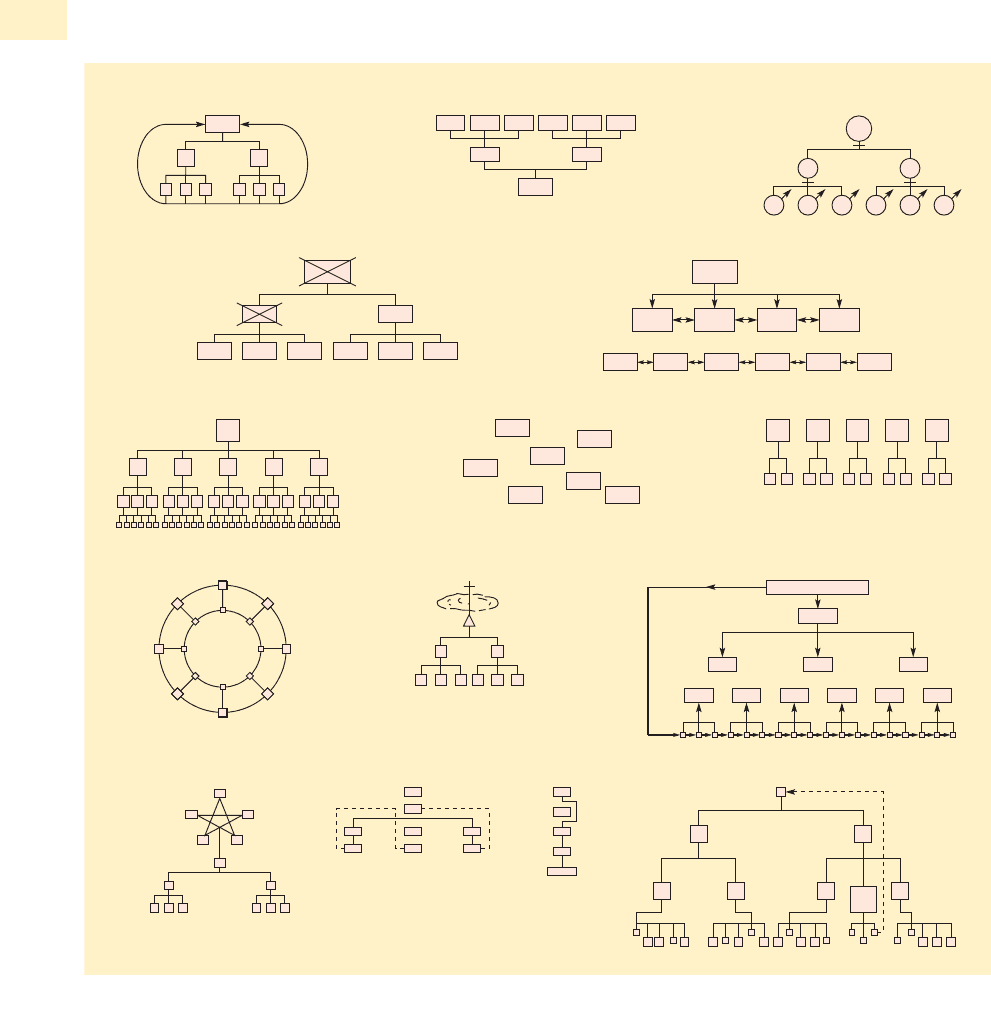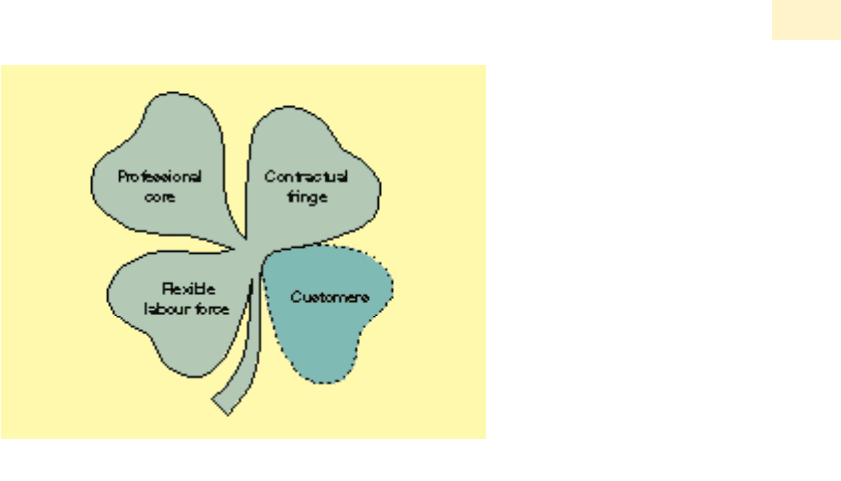Mullins L.J. Management and organisational behaviour, Seventh edition
Подождите немного. Документ загружается.


Lawrence and Lorsch sought to answer the following questions:
1 What are the differences in the environmental demands facing various organisa-
tions, and how do these demands relate to the internal functioning of effective
organisations?
2 Do organisations operating in a stable environment make greater use of the formal
hierarchy to achieve integration, and if so, why? Is it because less integration is
required, or because decisions can be made more effectively at higher levels of the
organisation or by fewer people?
3 Is the same degree of differentiation in orientation and departmental structure
found in organisations in different industrial environments?
4 If greater integration is required among functional departments in different indus-
tries, does this influence problems of integrating different parts of the organisation
and the methods of achieving integration?
Differentiation and integration
The internal structures of the firms were analysed in terms of ‘differentiation’ and
‘integration’.
Differentiation describes ‘the difference in cognitive and emotional orientation
among managers in different functional departments’ with respect to:
■ the goal orientation of managers – for example, the extent to which attention was
focused on particular goals of the department;
■ the time orientation of managers and relation to aspects of the environment with
which they are concerned – for example, longer-term horizons, or short-term hori-
zons and problems requiring immediate solutions;
■ the interpersonal relations of managers to other members – for example, a manage-
rial style based on concern for the task, or on concern for people relationships; and
■ the formality of structure – for example, the extent of mechanistic or organic design.
Integration describes ‘the quality of the state of collaboration that exists among
departments that are required to achieve unity of effort by the demands of the envi-
ronment’. It is the degree of co-ordination and co-operation between different
departments with interdependent tasks. Lawrence and Lorsch’s view of integration was
not the minimising of differences between departments and the provision of a
common outlook. It was the recognition that different departments could have their
own distinctive form of structure according to the nature of their task, and the use of
mediating devices to co-ordinate the different outlooks of departments.
Given the possibility that different demands of the environment are characterised by
different levels of uncertainty, then it follows that individual departments may develop
different structures. The study of the firms in the plastics industry supported this
hypothesis and Lawrence and Lorsch found a clear differentiation between the major
departments of research, production and sales.
■ Research was more concerned with the long-run view and was confronted with
pressures for new ideas and product innovation. The department operated in a
dynamic, scientific environment and had the least bureaucratic structure.
■ Production was more concerned with the here and now, short-term problems such
as quality control and meeting delivery dates. The department operated in a fairly
stable, technical environment and had the most bureaucratic structure.
■ Sales was in the middle between research and production. The department was con-
cerned with chasing production and had a moderately stable market environment.
The two most successful firms were those with the highest degree of integration
and were also among the most highly differentiated.
CHAPTER 16 PATTERNS OF STRUCTURE AND WORK ORGANISATION
645
Different
structures for
individual
departments

This view of differentiation and integration was confirmed in the subsequent study of
firms in the container and consumer food industries. In this part of the study a com-
parison was made of both high and low performance firms operating in different
environments. The aim was to discover what forms of organisation structure were
required for different environments. It was concluded that the extent of differentiation
and integration in effective organisations will vary according to the demands of the
particular environment.
■ The more diverse and dynamic the environment, the more the effective organisa-
tion will be differentiated and highly integrated.
■ In more stable environments, less differentiation will be required but a high degree
of integration is still required. Differences in the environment will require different
methods of achieving integration.
The mechanisms used to achieve integration depend on the amount of integration
required and the difficulty in achieving it.
■ In mechanistic structures, integration may be attempted through the use of policies,
rules and procedures.
■ In organic structures, integration may be attempted through teamwork and mutual
co-operation.
■ As the requirements for the amount of integration increase, additional means may
be adopted, such as formal lateral relations, committees and project teams.
■ When there is a high degree of differentiation, the use of assigned ‘integrators’ or
possibly a separate unit with a number of integrators were suggested. Because they
are not dominated by any particular perspective, these integrators can help resolve
problems of co-ordination and work programming between different departments.
It is important, however, to achieve the right balance of integration. Too high a level of
integration may involve costs which are likely to exceed possible benefits. Too low a
level of integration is likely to result in departments ‘doing their own thing’, poorer
quality decisions and failure to make the best use of resources.
25
Patterns of organisation and management
Lawrence and Lorsch do not see the classical and human relations approaches as being
out of date but as part of a continuum of patterns of organisation and management
related to the environment in which they operate. The work of Lawrence and Lorsch is
an extension of this continuum and their case for ‘a contingency theory of organisa-
tions’ has provided a further insight into the relationship between organisation
structure and the demands of the environment.
The contingency approach draws attention to the situational factors which account for
variations in the structure of organisations. It is more concerned with differences
among organisations than with similarities. It rejects a number of assumptions of the
classical and human relations approaches, and the idea of one best form of structure.
For its part, however, the contingency approach tends to assume that organisational
performance is dependent upon the degree to which the structure of the organisation
matches the prevailing contingencies.
646
PART 6 ORGANISATIONAL STRUCTURES
Organisation
structure and
different
environments
Integrating
mechanisms
EVALUATION OF THE CONTINGENCY APPROACH

Hunt explains the concept of contingency as follows:
The concept of contingency also implies that there is no one, absolute ‘best’ design; rather, there
is a multitude of possibilities and the best or preferred choice will be contingent on the situation
being analysed. Universal models designed to suit all situations are therefore rejected. This is
consistent with the fact that most organizations are networks of a variety of bits of design rather
than conforming, as one entity, to a particular model. So we might find units of bureaucracy,
units of matrix structures, units with project teams, units with extremely loose, almost ad hoc
structures – and all these within, say, the same oil company. In this sense, the contingency theor-
ists merely reflected the findings of hundreds of researchers. There are common elements in the
hierarchies of different organizations but there are also very many differences peculiar to the
local situation.
26
As with other approaches to organisation and management, contingency theory has
been subject to a number of criticisms or doubts about its practical value to manage-
ment. Among the writers who have assessed the contribution and relevance of the
contingency approach are Child,
27
Dawson
28
and Mintzberg.
29
The criticisms, difficulties and limitations of the contingency approach usually
revolve around seven main issues.
1 Causal relationship. The nature of the causal relationship between organisation
and performance is open to question. Most contingency models imply a causal re-
lationship between structure, as an intervening variable, and performance as a
dependent variable. It is probable, however, that certain factors such as the personal
characteristics of management and staff, and changes in product markets and
market conditions, influence performance independently of structure. It is also pos-
sible that organisational performance is an influence on structural design. Managers
may be stimulated to make changes to structure as a result of feedback of informa-
tion on performance.
2 Organisational performance. Implicit in contingency theory is the notion that the
fit among components of the organisation and situation variables is related to max-
imising organisational performance. However, organisational performance is
multifaceted and the measurement of performance applied in many of the contin-
gency studies has not been precise. It is impossible to derive a single criterion for the
appropriateness of the fit among various features of organisation and improved per-
formance. (Recall, for example, the discussion on the fallacy of the single objective
and the eight key areas of performance and results, in Chapter 5.)
3 Independent variables. The supposed status of the independent ‘contingent’ vari-
ables as the ‘given’ and beyond the control of members of the organisation is open
to question. Large organisations may be in a position to exercise control over certain
aspects of their environment. For example, an organisation may be in a monopoly
position or have its own protected niche in the environment. Organisations may
also be able to influence their environment through, for example, advertising or
political pressure groups. Some organisations, therefore, may be less dependent
upon their environment and in a more secure position compared with other organ-
isations. Any mismatch in contingency factors is likely to have less severe
consequences for survival and level of performance.
4 Multiple contingencies. Different patterns of contingency factors have distinctive
implications for organisational design. Organisations face multiple contingencies
and there is potential for multi-way relationships among the range of organisational
variables. Different contingencies may result in the need for different patterns of
structure (as with a hybrid form of organisation discussed above) – for example, a
department operating within a dynamic environment and demanding a more
organic structure, within an organisation where other departments function within
a more bureaucratic structure.
CHAPTER 16 PATTERNS OF STRUCTURE AND WORK ORGANISATION
647
Criticisms/
limitations

5 Planned change. Contingency models of organisation fail to give sufficient empha-
sis to unanticipated consequences of planned change – for example, the effects of
the introduction of new technology on the internal working of the organisation or
on the social interactions among groups of people engaged in certain activities.
6 Power factors. Organisation structure is not necessarily determined only by imper-
sonal contingency conditions, but also by what are referred to as ‘power’ factors.
The pressure of external control – such as government control of public sector
organisations; the political context; the power needs of various members and man-
agerial preferences; the culture of the organisation and the power of social norms –
also enters into the design of structure.
7 Timing of organisational change. Most organisations operate under conditions of
constant change, and this raises the question of the frequency and timing of organ-
isational change. Developing organisations cannot, without difficulty, change their
formal structure at too frequent an interval. There must be a significant change in
contingency factors before an organisation will respond. Changes in structure tend
to lag behind situational change. There is, therefore, a degree of luck about whether
at any moment in time there is a good fit between structure and prevailing contin-
gency factors.
Despite the criticisms and limitations of contingency theory, it has provided a further
insight into our understanding of relationships among factors influencing the struc-
ture, management and operations of work organisations. An appropriate form of
organisation will help prevent problems caused by unsuitable structures. The contin-
gency approach has relevance in terms of, for example, division of work and
co-ordination of activities; hierarchy and definition of responsibilities; methods of
work; motivation and commitment of staff; and style and systems of management.
The basic concepts of the contingency approach help managers to develop a more
thorough understanding of complex situations and to take appropriate action.
30
It also
draws attention to the difficulties with mixed forms of organisation, and to the im-
portance of different structures for different activities and situations – as illustrated in
the example of M*A*S*H given earlier in the chapter.
According to Robey, modern contingency theory provides an increasing amount of
empirical research, it defines variables ignored in earlier work, and it directs the atten-
tion of the manager to the contingencies to be considered in the design of organisation
structure. However, the contingency approach runs the risk of concluding that ‘it all
depends on everything’, and the greatest danger is the over-emphasis on differences
between organisations and the exclusion of similarities. If the contingency approach is
to be useful in guiding organisation design it should not treat every situation as being
unique. ‘Rather it must strike a balance between universal prescriptions and the state-
ment that all situations are different (which is really no theory at all). Thus, modern
theory uses a limited number of contingencies to help explain structural differences
between organizations.’
31
Vecchio also refers to the contingency approach as ‘it depends’. However, this is not
meaning to be evasive, but assuming that there are a number of important dependen-
cies and acknowledges:
the difficulty of offering simple general principles to explain or predict behavior in organizational
settings … If you ask a contingency researcher for a simple answer to a seemingly simple ques-
tion, you should expect to be given a fairly complex and highly qualified answer. Because human
behavior is itself complex, a statement of behavioral principles must also be complex.
32
648
PART 6 ORGANISATIONAL STRUCTURES
CONTRIBUTION OF CONTINGENCY THEORY
Not every
situation is
unique

In Chapter 2 we drew attention to national culture as a feature of organisational behav-
iour. Several writers have sought to examine whether the principles of contingency
theory hold true in different national contexts. Hickson et al. investigated 70 manufactur-
ing units in Britain, the United States of America and Canada. They discovered that while
there were differences in organisational arrangements, these could not be attributed to
cultural effects. The relationship between variables, such as size, and the degree of spe-
cialisation and formality was found to be constant in all three countries, and the
researchers suggested this would ‘hold for work organisations in all societies’.
33
Maurice, Sorge and Warner, however, concluded that ‘matched’ organisations in dif-
ferent societies grow in contrasting ways, which may be the result of distinctive
patterns in the wider society. For example, their research showed that British organisa-
tions appeared to grow laterally – that is, to develop large numbers of specialised
managers. This may be a reflection of the comparatively specialised nature of British
education and the influential role played by the professions. In contrast, the smaller
number of categories of workers found in the German organisations studied may be
traced back to the notion of the company apprenticeship prevalent in that country. In
this way culture can itself be seen as a contingent factor.
34
Whatever the perspective, it is important for future managers to understand the
effect of national culture on behaviour. This is of increasing significance with the
growth of multicultural workforces and the effects of the European Union on organisa-
tional design. Schneider and Barsoux discuss the multi-dimensional impact of culture on
organisations and management and maintain that it would be a mistake to base a pre-
diction regarding structure or process on a single cultural dimension. ‘Managers need
to recognise that the relationship between cultural dimensions and structure (or
processes) are not simple cause–effect links, but instead, are multidetermined.’
35
An interesting set of caricatures for organisation charts of different countries is given
in Figure 16.5.
Whatever the criticisms or limitations of contingency models, the application of
modern contingency theory can help contribute to more effective performance. The
effects of increased economic pressures and demands for greater competitiveness have
drawn attention to the importance of structural variables. The movement towards
tighter and leaner organisations has drawn attention to the importance of alternative
forms of structure and placed increased emphasis on the demand for flexibility. For
example, Morgan argues that we are leaving the age of organised structures and moving
into an era where self-organisation will become a key competence. Looser organisa-
tions and different forms of control will entail a close examination of such issues as
growth and size, teamwork, decentralisation, franchising and subcontracting.
36
Rapid developments in information technology have also highlighted the need for
review of structural design. Organisations have reduced the size of their workforce, espe-
cially full-time staff, and have flatter structures with fewer levels of authority. For
example, in order to free management to concentrate on core activities, businesses are
making increasing use of outsourcing and having a wider range of non-core services pro-
vided to them by specialist service providers.
37
Furthermore, as organisations downsize,
management consultancies continue to grow.
38
Such movements lead to debates about
the perceived benefits for businesses and the ability of managers to retain responsibility.
CHAPTER 16 PATTERNS OF STRUCTURE AND WORK ORGANISATION
CULTURE AS A CONTINGENT FACTOR
649
ALTERNATIVE FORMS OF STRUCTURE

Crainer suggests that the organisation is changing and the world of work is moving
into a new age. Crainer lists ‘seven habits of the new organisation’:
1Flexible and free-flowing
2 Non-hierarchical
3Based on participation
4Creative and entrepreneurial
5Based round networks
6Driven by corporate goals
7Utilising technology as a key resource.
39
650
PART 6 ORGANISATIONAL STRUCTURES
IrishAmerican Women’s Lib
Latin American British
Arabian ItalianChinese
United Nations Vatican Norwegian
(former) Soviet Union French Albanian (former) Yugoslav
Figure 16.5 Caricatures of organisation charts for different countries
Source: Reed Business Information, reprinted with permission.
Seven habits
of new
organisations

The nature of work is being rede-
fined and this has created strong
pressures for greater flexibility in
patterns of work organisation and in
the workforce. For example,
Bouchikhi and Kimberly suggest that
the major challenge to organisations
by external world trends is one
of openness to individuals’ needs
and democratisation. Organisations
must change into ‘customised
workplaces’. The challenge for
management in the twenty-first
century is to fully internalise the
diverse and changing needs of
individuals, and to investigate
employee-driven flexibility.
40
A significant approach was Atkinson’s idea of the flexible firm.
42
He suggests that firms
are really looking for three kinds of flexibility:
■ functional flexibility in order to permit the rapid redeployment of employees among
different activities and tasks (perhaps involving the practice of multi-skilling);
■ numerical flexibility in order to restructure so as to adjust the number of employ-
ees to match the level of demand for labour;
■ financial flexibility in order that pay and other employment costs reflect the supply
and demand of labour and in order to shift to new pay and remuneration systems.
As a result, Atkinson suggests that flexible firms have attempted to develop an organisa-
tion structure based on a central, stable ‘core’ group of full-time permanent career
employees who undertake the organisation’s key, firm-specific activities and with empha-
sis on functional flexibility; supported by peripheral and numerically flexible groups of
workers including agency temporaries, subcontracting, self-employed and part-time staff,
whose numbers, in theory, can expand or contract according to market conditions.
The European Commission has drawn attention to the rapid expansion of temporary
work in the European Union in recent years. ‘The trend towards temporary work is
likely to continue, because it suits both individuals and business by encouraging job
creation and flexibility. It enables companies to cope with workload fluctuations, and
to use agencies when they need employees with specific skills.’
43
CHAPTER 16 PATTERNS OF STRUCTURE AND WORK ORGANISATION
THE DEMAND FOR FLEXIBILITY
Flexibility at work in action
The business case for flexibility is clear. In common with many other businesses, Lloyds
TSB operates in an extremely competitive environment. Customers increasingly wish to
access their finances whenever convenient for them and it is therefore no longer possible to
be a 9 to 5 organisation. Flexibility is the key to staying competitive and we have to con-
sider when, where and how to deliver services to ensure that we can provide a high quality
customer service … Implementing flexible management that really works, however, is not
for the faint-hearted. We had to radically rethink our approach, which had become associ-
ated with arrangements for women and children, with most of the uptake at junior clerical
level. This has involved looking at the way work is organised and at organisational culture.
Sir Brian Pitman, Chairman of Lloyds TSB Group plc
41
The flexible
firm
An increase
in flexible
working
651
Photo: Adam Smith/Getty Images

Since April 2003 employees with children under the age of six years (18 years for dis-
abled children) have been entitled legally to apply for flexible working and to have their
employer seriously consider the request. This is likely to lead to a noticeable increase in staff
seeking part-time and flexible working including job-sharing and term-time-only working.
Recent advances in computerisation and telecommunications have had a further sig-
nificant effect on the opportunities for flexible working. People can work from almost
any geographic location: from head office, a satellite office, a shared access telecentre;
or from their home, hotel room or car. An increasingly popular means of teleworking is
telecommuting where staff work from home with a computer network telephone and
fax.
44
Many well-known organisations including the Nationwide Building Society,
Lloyds TSB, Scottish Widows, the Co-operative Bank and the Britannia Building Society
are now turning to teleworking.
45
The potential advantages of teleporting in the public
sector is also receiving greater attention. With demands for continuing improvement
in service delivery an increasing number of local authorities and housing associations
have introduced to varying extents some form of teleworking.
46
From a discussion of the opportunities and challenges of telecommuters, Manochehri
and Pinkerton conclude that telecommuting has come of age. The technological develop-
ments have made it possible, and economic and social factors have made it necessary.
Managers have no choice but to learn how to take advantage of this new approach.
The advantages of telecommuting are already clear and distinct. Several trends such as further
growth in information technology, the expanding role of the service sector, the emergence of virtual
corporations and the diverse needs of the employees will guarantee a higher reliance on telecom-
muting as a viable alternative … Managers have to appreciate the telecommuting management
challenges and determine how to overcome them. If implemented and managed properly, telecom-
muting can be a valuable asset to an organization and to the people it employs.
47
A challenge for managers
The use of information communications technology and moves towards an increasingly
flexible workforce call for attention to appropriate structures of organisation and systems
of management. For example, Lucas maintains that the big challenge for managers in the
new millennium is: ‘How do you create trust, communicate effectively, and foster team-
work with a group of people who could be working anywhere from their dining room
table to an airport lounge?’ Lucas suggests that this requires a sound performance man-
agement system, the effective management of virtual teams and managing
communication. Flexible working calls for flexible managers who can cope with uncer-
tainty, ambiguity and constant change; management development programmes; and a
fundamental review of the role of a manager in the new world of work.
48
The influence of flexibility on the job satisfaction of staff is considered in Chapter 18.
One particular approach to flexible structural design and the core and complementary
model of employment is Handy’s concept of the ‘shamrock’ organisation.
49
The three
leaves to each stem of the shamrock are symbolic of the organisation which is seen as
made up of three distinct groups of people who are managed, organised and paid dif-
ferently, and with different expectations: the professional core; the contractual fringe;
and the flexible labour force. (See Figure 16.6.)
652
PART 6 ORGANISATIONAL STRUCTURES
TELECOMMUTING
THE SHAMROCK ORGANISATION

■ The professional core comprises qualified professionals, technicians and managers
essential to the existence and effective performance of the organisation. Collectively,
these people own the knowledge which distinguishes the organisation. They get
most of their identity and purpose from their work and are likely to be committed
to it and dependent on it. The professional core are expensive and the tendency has
been for organisations to restructure in order to reduce their numbers.
■ The contractual fringe comprises those people, or other organisations, outside of the
organisation who provide specialist services and undertake all non-essential work
which can be done by somebody else, and in theory are able to do it better for less.
The organisational principle is that the contractual fringe are paid for results not for
time, in fees and not wages. It is wise for the shamrock organisation to put boring and
repetitive work out to contract, specifying the results expected and paying the fee.
■ The flexible labour force represents all those part-time and temporary workers who
make up the fastest growing group in the pattern of employment. It provides for
flexibility in human resourcing. People are brought in as occasional extra part-time
labour or temporary staff as changing work situations demand. Their commitment
will be to a job and work group rather than to a career or organisation. Part-time or
temporary work may be a matter of choice, not just a necessity.
According to Handy, organisations now have three significant workforces, each with a
different kind of commitment to the organisation and a different set of expectations, and
each workforce needs to be managed in different ways. The concept of the shamrock
organisation can encourage managers to question the operations of their organisations. It
gives rise to important decisions concerning what activities, and which people, should
belong to the core; and concerning the management and control of subcontracting, and
of the flexible workforce. Managers could use the concept of the shamrock organisation
and how this might best be adapted and utilised in a review of structure to suit the par-
ticular circumstances of the nature and operations of their own organisation.
The increase in the flexible labour force is particularly noticeable with the growth of
service industries. Services are created and consumed simultaneously. Unlike manufac-
turing, services are time-perishable and cannot be stored. The flexible labour force has
increasingly been used as a cheaper and more convenient means of dealing with the
peaks and troughs of demands, and as a means of adjusting the level of service to
match changing customer requirements. Although casual and part-time staff are
unlikely to have the same degree of commitment or ambition as the core it is impor-
CHAPTER 16 PATTERNS OF STRUCTURE AND WORK ORGANISATION
653
Figure 16.6 Representation of Handy’s shamrock organisation
Three
significant
workforces

tant that they are taken seriously and regarded as a valuable part of the organisation. If
treated as casual labour such people respond casually. The flexible workforce should be
treated with respect, given fair and equitable treatment, adequate training and status,
and decent pay and conditions. If casual and part-time staff are to respond in a positive
way and provide a high standard of service then they have to be managed in a consid-
erate and effective manner.
Handy also refers to the growing practice of saving labour in the core by introducing
another, informal, and unpaid, form of subcontracting – that of getting customers to do
some of the work of the organisation. Examples include the collection rather than the
delivery of goods, self-assembly furniture, automated banking facilities, and self-serve
petrol. In the hospitality industry, there are many examples of this ‘serve yourself’ phi-
losophy. Examples include the provision of shoe-cleaning equipment or machines;
hotel guests making their own tea and coffee in their rooms; restaurant self-service
breakfast and buffet meals; the provision of vending machines for snacks and beverages.
Handy suggests that although on the face of it the shamrock is logical, these are not
easy organisations to run. Each leaf of the shamrock has to be managed differently yet
as part of the whole. The core is the critical hub of the organisational network and this
raises important questions as to what activities belong in the core; and which people
belong in the core, and for how long. Fixed-term contracts will be an increasing fea-
ture. Employing fewer people brings with it the need for better people, and pressure for
alertness and quality will place greater demands on the core people.
Whatever its structure, the various operations of the organisation have to be distributed
among its members. It is necessary to plan, organise, direct and control their activities.
Delegation relates to the location of decision-making within the organisation. It is a funda-
mental principle of management that for organisational effectiveness there must be
delegation.
50
This gives rise to questions about the extent and nature of delegation and
empowerment, the manager–subordinate relationship, and the maintenance of manage-
ment control within the formal structure of the organisation. This is discussed fully in
Chapter 21.
654
PART 6 ORGANISATIONAL STRUCTURES
Customers as
the fourth
leaf?
Challenges of
the shamrock
THE NATURE OF DELEGATION AND EMPOWERMENT
CRITICAL REFLECTIONS
‘We trained very hard, but it seemed every time we were beginning to form up into teams we
would be reorganised. I was to learn later in life that we tend to meet any new situation by reor-
ganising and a wonderful method it can be for creating the illusion of progress while producing
confusion, inefficiency and demoralisation.’ (Gaius Petronius, AD 66)
What are your own views?
‘The current trend towards flatter organisational structures leads to a decline in staff motivation
and in the desire to succeed.’
Debate.
